Total Symmetry Chess
After I presented my Fischer-Benko Chess (FBC) to many of my friends, and to people with whom I play standard Chess and Chess960 at Chess.com and Lichess.org, I heard many opinions on it. Many of the people like it and find it interesting and difficult, but even from those who were really friendly toward me, I received some harsh criticism. In short, they believe that asymmetry is too wild to be tamed. I tried to explain them that the better player has a chance to choose superb position for their 5 pieces out of 8. Yes, it puts better player into a better position but so what? Is it not a goal of every chess variant that better players always win? Anyway, I decided to please critics too, and therefore I created and tested this variant: Total Symmetry Chess (TSC) or alternatively, 24 Positions Chess. This is also a random position Chess, but the pieces are placed symmetrically in regard to not just one, but two symmetry axes, vertical and horizontal. There are "only" 24 random positions but all of them are as fair for both players as the standard starting position. If someone is ready to develop and/or study 24 opening theories I'd be truly amazed! The rules are identical to those of standard Chess with only one exception: there is no castling. One of the 24 random positions is the standard Chess position, but without castling it is not the same game any longer.
Setup
We first place pawns on their standard positions. For the setup of pieces we cast a single die.
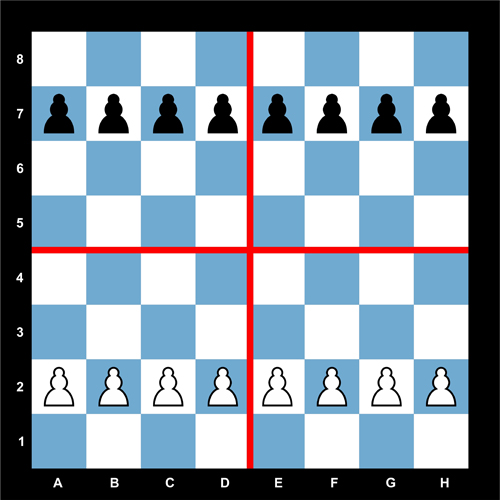
We cast a die to determine place for rooks first (but it can be any other piece). We need a number from 1 to 4. If we get a bigger number we throw the die again.
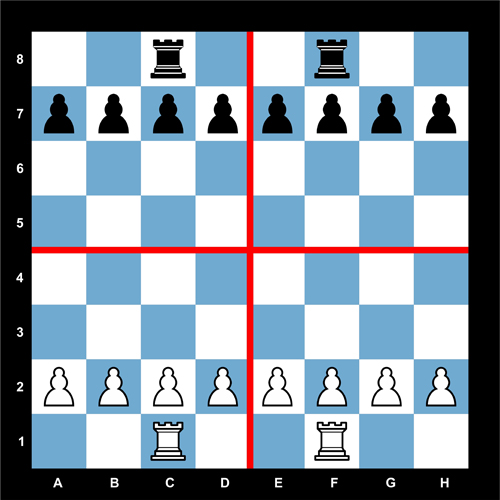
I got number 3 so I placed rooks like in picture above, symmetricay on all sides in regard to vertical and horizontal axes.
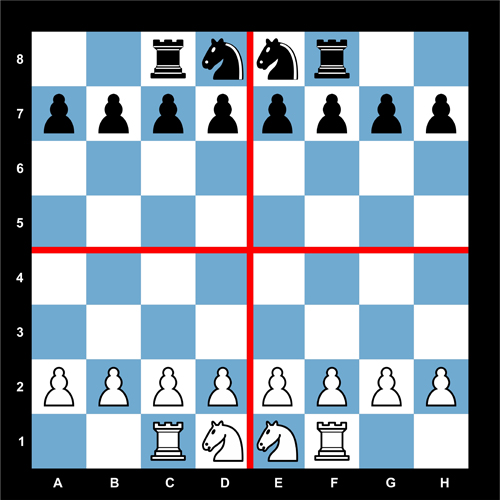
We cast a die again for the second type of pieces, in this case for Knights, and whatever number we get, we divide it with 2 and round up to get a number from 1 to 3 (1 or 2 = 1, 3 or 4 = 2, 5 or 6 = 3). So we need to cast the die only once. I got number 5 and placed knights at their third free squares in respect to both symmetry axes.
Now, we need the position for bishops. Once again, we cast a die just once. Odd numbers = 1, even numbers = 2.
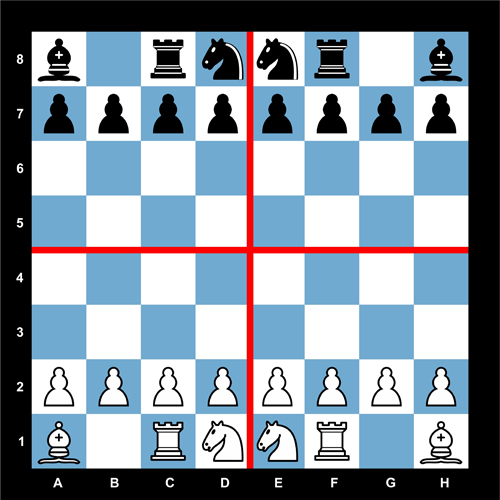
I got odd number and placed bishops at their first free squares.
We don't need to throw a die again. Royal pieces go to the remaining free squares with only one rule: the white queen must be placed on the white square and the black one on the black square.
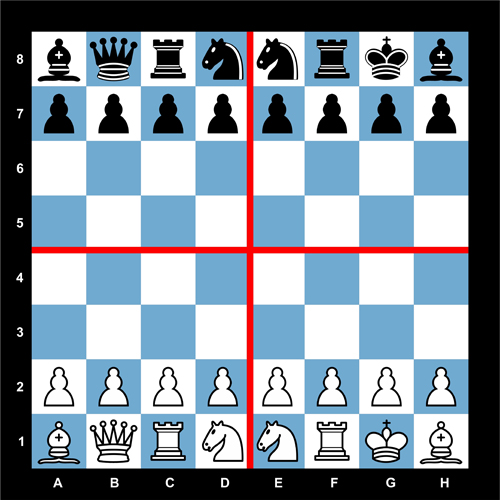
From this position, we play the game normally according to the rules of chess but without castling.
Here you can see some interesting possibilities out of the 24 starting positions.
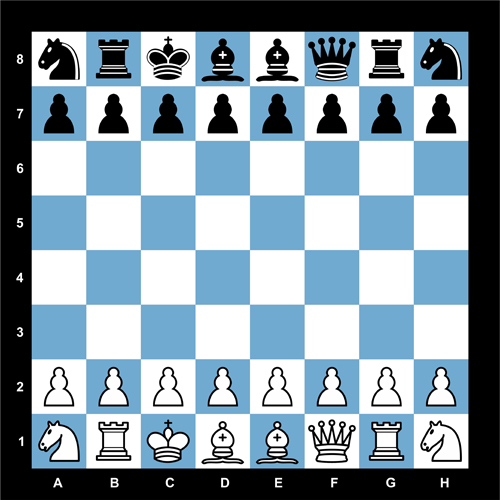
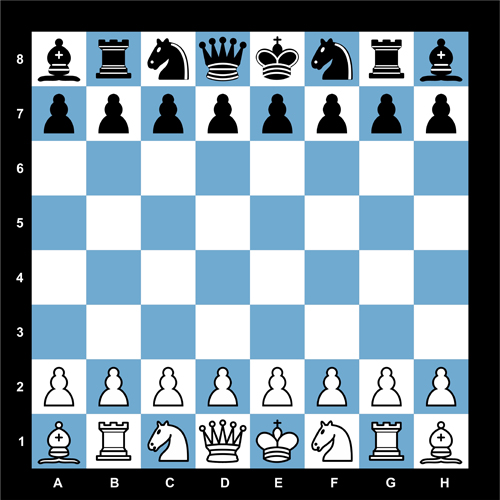
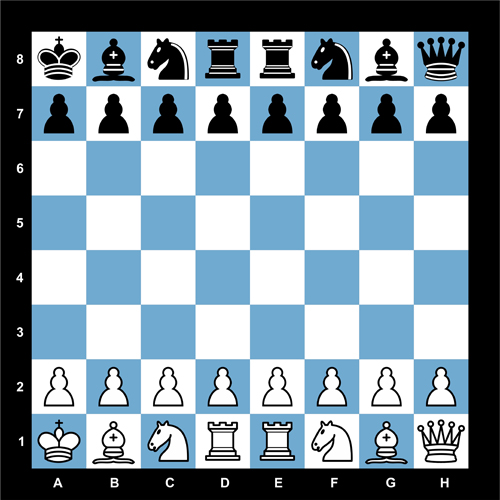
I've been playing these positions against the computer for some time. The feeling is much different from Chess960 or from my own Fischer-Benko Chess. There is some beauty in all these positions and they are quite different among themselves. This is not a commercial chess variant and everybody is welcome to play it. I hope you'll like it!
Notes
Here are all 24 possible initial positions for white. Positions for black are mirrored.
1 - RNBQKBNR
2 - RNKBBQNR
3 - RBNQKNBR
4 - RBKNNQBR
5 - RQNBBNKR
6 - RQBNNBKR
7 - NRBQKNRN
8 - NRKBBQRN
9 - NBRQKRBN
10 - NBKRRQBN
11 - NQRBBRKN
12 - NQBRRBKN
13 - BRNQKNRB
14 - BRKNNQRB
15 - BNRQKRNB
16 - BNKRRQNB
17 - BQRNNRKB
18 - BQNRRNKB
19 - KRNBBNRQ
20 - KRBNNBRQ
21 - KNRBBRNQ
22 - KNBRRBNQ
23 - KBRNNRBQ
24 - KBNRRNBQ
Total Symmetry Chess Sample Game
Davor Vujacic (White) – Srecko Lukic (Black) July 11, 2020
Position number 16 (BNKRRQNB) was randomly chosen using random number generator (range from 1 to 24). The game was played online at Lichess.org - From Position game.
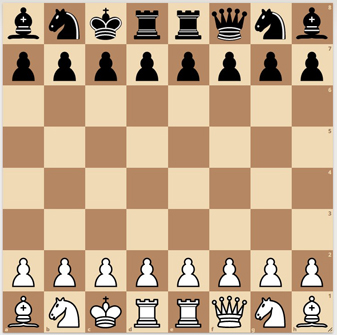
1.) e4 b6 2.) d4 g6 3.) Nc3 d5 4.) f3 dxe4 5.) fxe4 Bxd4 6.) Nge2 Be3+

7.) Kb1 e6 8.) g3 Bd2 9.) Rxd2 Rxd2 10.) Rc1 Red8 11.) b3 Nd7 12.) Qf4 Nc5 13.) Nb5 R8d7 14.) Ned4 Qh6 15.) Qxh6 Nxh6 16.) h3 a6 17.) Nf3 Rf2 18.) Nc3 Nxe4 19.) Ne5 Nd2+ 20.) Kb2 Bxh1 21.) Rxh1 Rd8 22.) Rd1 b5 23.) Nc6 Rd6
24.) Ne7+...
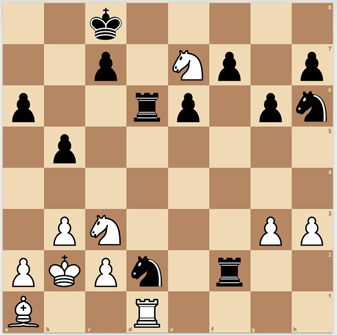
24.) ...Kd7 25.) Nxg6 hxg6 26.) Kc1 b4 27.) Na4 Nxb3+ 28.) axb3 Rxd1+ 29.) Kxd1 Rf1+ 30.) Ke2 Rxa1
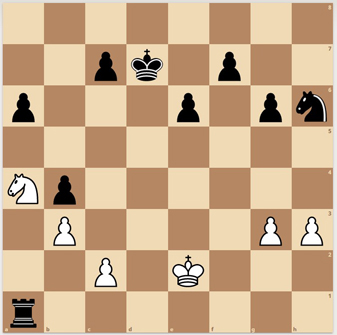
0-1
White resigned, Black is victorious
 This 'user submitted' page is a collaboration between the posting user and the Chess Variant Pages. Registered contributors to the Chess Variant Pages have the ability to post their own works, subject to review and editing by the Chess Variant Pages Editorial Staff.
This 'user submitted' page is a collaboration between the posting user and the Chess Variant Pages. Registered contributors to the Chess Variant Pages have the ability to post their own works, subject to review and editing by the Chess Variant Pages Editorial Staff.
By Davor Vujacic.
Last revised by Davor Vujacic.
Web page created: 2020-06-22. Web page last updated: 2020-07-02
